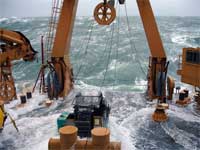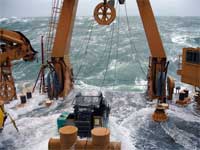 NARRAGANSETT, R.I. – January 18, 2012 – A University of Rhode Island marine scientist has returned from a six-week research cruise to the Bering Sea and Chukchi Sea, the first time oceanographers have studied this Arctic region in winter during modern times.
NARRAGANSETT, R.I. – January 18, 2012 – A University of Rhode Island marine scientist has returned from a six-week research cruise to the Bering Sea and Chukchi Sea, the first time oceanographers have studied this Arctic region in winter during modern times.
“The area is a big black box in winter; what goes on there in the marine environment is unknown,” said Robert Campbell, a marine research scientist at the URI Graduate School of Oceanography and a resident of Saunderstown. “We need to have a basic understanding of the ecosystem so we can predict how climate change may affect it.”
The expedition was conceived by Campbell and co-principal investigators Carin Ashjian (Woods Hole Oceanographic Institute), an alumna of the Graduate School of Oceanography, and Steve Okkonen (University of Alaska), and funded by the National Science Foundation.
 Campbell, who studies tiny zooplankton that are an important food source for fish and whales, traveled with a team of other oceanographers aboard the Coast Guard icebreaker Healy, the only currently operating U.S. Arctic icebreaker, to the waters north and west of Alaska to conduct a wide range of measurements and collect plankton samples.
Campbell, who studies tiny zooplankton that are an important food source for fish and whales, traveled with a team of other oceanographers aboard the Coast Guard icebreaker Healy, the only currently operating U.S. Arctic icebreaker, to the waters north and west of Alaska to conduct a wide range of measurements and collect plankton samples.
“I’ve been out there a number of times in spring and summer to try to understand what might happen if the ice conditions in the region change and how those changes will affect the growth and development of the zooplankton,” he said. “But before we can predict what might happen with climate change, we have to understand what is happening today. And we don’t know much about what’s happening there in winter.”
Day after day, Campbell and colleagues deployed a system of nets to collect copepods and krill to conduct studies of their physical condition and activity levels. They also used a video plankton recorder that took pictures of the plankton in their natural environment and a number of other instruments to measure various chemical and physical water properties.
“Certain species go into a resting stage like hibernation in deep water during the dark winter and don’t return to the surface to grow and reproduce until spring when conditions are better,” Campbell explained. “But in this area, because the continental shelf is so wide, it may not be possible for them to move to deep water and still recolonize the shelf in spring. We assumed they would just stay on the shelf through the winter.”
His first impressions suggest that this may be true.
“They were feeding, they seemed to be very active, they had normal respiration rates, and they had plenty of lipid, which makes them well suited to get through the winter,” Campbell said of the zooplankton he collected.
Krill, which travel northward on currents from the Bering Sea to the Chukchi Sea, are an especially important food source for bowhead whales. Copepods in the genus Calanus are also a vital link in the food chain between marine plants and fish.
“But not all copepod species are created equal,” said Campbell. “Some have a large lipid sac that makes them a good source of food, but others don’t have that lipid reserve. If changes are happening and one group does better than the others, that might have a cascading effect across the ecosystem.”
According to Campbell, the Arctic is one of the regions that scientists know the least about, and it is also where the biggest changes are likely going to occur due to global warming.
“We’re already beginning to observe changes there, so it’s important to get a good understanding of the ecosystem now before the changes become too great,” he said.
The conditions that Campbell and the other oceanographers aboard the ship endured were quite extreme. In the Chukchi Sea, wind chill temperatures were sometimes below -40 degrees, and those working on deck had to ensure that no skin was exposed to the elements for fear of frostbite.
“In the Bering Sea we had a different problem,” Campbell said. “It wasn’t as cold, but the seas were so rough that it made it difficult to do our work. One time the water was so rough that our nets were trashed and we had to pull them in and repair them.”
The URI scientist said that there is a great deal of analysis still to be done of the data he collected from the Bering and Chukchi Seas. He also will return to Barrow, Alaska again this year as part of the Arctic Observing Network, an effort to conduct the same measurements year after year to monitor for signs of climate change.

